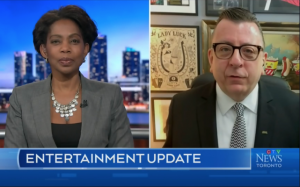NEWSTALK 1010: AUTHOR MATT CAHILL + ROBERT HARRIS + STAN LEE
 On this week’s Richard Crouse Show we meet Matt Cahill. He has a private practice and is a member of the College of Registered Psychotherapists of Ontario and is a writer whose debut novel, “The Society of Experience,” was picked as a must-read by Harper’s Bazaar magazine. His short stories have been widely published and his essay “On Madness Within Imagination” was selected for Best Canadian Essays 2017. His new book, “Radioland,” is a mesmerizing literary thriller, where music, fame and magic wind together in an eerie mystery.
On this week’s Richard Crouse Show we meet Matt Cahill. He has a private practice and is a member of the College of Registered Psychotherapists of Ontario and is a writer whose debut novel, “The Society of Experience,” was picked as a must-read by Harper’s Bazaar magazine. His short stories have been widely published and his essay “On Madness Within Imagination” was selected for Best Canadian Essays 2017. His new book, “Radioland,” is a mesmerizing literary thriller, where music, fame and magic wind together in an eerie mystery.
Then, Robert Harris, bestselling author of “Fatherland,” “The Ghostwriter,” “Munich” and “Conclave.” His new novel, “Act of Oblivion,” is an historical novel that brilliantly imagines one of the greatest manhunts in history: the search for two Englishmen involved in the killing of King Charles I and the relentless foe on their trail.
Then, word legend gets kicked around a lot, but in this case it really fits. Stan Lee made an indelible mark on popular culture by co-creating some of the most popular characters in comic books. Without him there’d be no superheroes like Spider-Man, the X-Men, Iron Man, Thor, the Hulk, Black Panther and the list goes on and on. He is a legend and I got the chance to speak with him on the phone a couple of years before he passed away in 2018. He was in fine form, it’s a really fun interview and I wanted to share it with you again.
Listen to the whole thing HERE!
Here’s some info on The Richard Crouse Show!
Each week on the nationally syndicated Richard Crouse Show, Canada’s most recognized movie critic brings together some of the most interesting and opinionated people from the movies, television and music to put a fresh spin on news from the world of lifestyle and pop-culture. Tune into this show to hear in-depth interviews with actors and directors, to find out what’s going on behind the scenes of your favourite shows and movies and get a new take on current trends. Recent guests include Chris Pratt, Elvis Costello, Baz Luhrmann, Martin Freeman, David Cronenberg, Mayim Bialik, The Kids in the Hall and many more!
Listen to the show live here:
C-FAX 1070 in Victoria
SAT 5:00 PM to 6:00 PM
SUN 10:00 AM to 11:00 AM
CJAD in Montreal
SAT 8 PM to 9:00 PM
CFRA in Ottawa
SAT 8 PM to 9:00 PM
NEWSTALK 610 CKTB in St. Catharines
Sat 8:00 PM to 9:00 PM
NEWSTALK 1010 in Toronto
SAT 8 PM to 9:00 PM
NEWSTALK 1290 CJBK
SAT 8 PM to 9:00 PM
AM 1150 in Kelowna
SAT 11 PM to Midnight
BNN BLOOMBERG RADIO 1410
SAT 8 PM to 9:00 PM
Click HERE to catch up on shows you might have missed!








